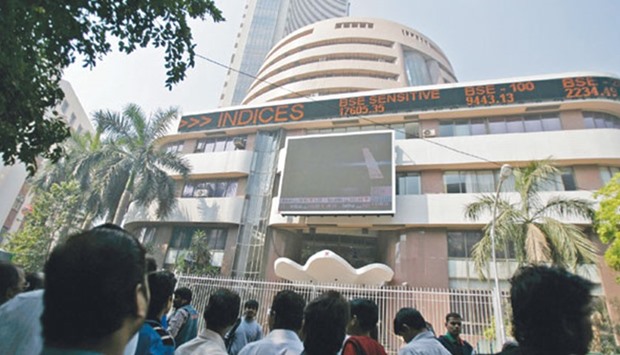Indian gauges of mid- and small-cap shares extended gains to records as a merger plan spurred a rally in banks.
State Bank of India (SBI) rose the most on the benchmark S&P BSE Sensex after the lender approved a merger plan with three of its units and Bharatiya Mahila Bank amid a government push to strengthen the nation’s fragmented banking industry. Tata Steel, the best performer on the Sensex this year, advanced for a third day this week. Piramal Enterprises rose to a record.
The Sensex closed 0.17%, or 46.44 points, lower at 28,077, while the Nifty 50 lost 0.07%, or 6.35 points, to close down at 8,666.90. Overseas funds have been net buyers of Indian shares for 27 days in a row, the longest stretch since 2013, as above-average rainfall after back-to-back droughts improves the outlook on company earnings and global central banks remain supportive of growth. Foreigners bought a net $117mn of local shares on August 16, taking this year’s inflows to $5.7bn, the most in Asia after Taiwan and South Korea.
“The increase in foreign inflows is giving Indian equities a chance to catch up with global peers,” said Kaushik Dani, a fund manager at Karvy Stock Broking in Mumbai. “It is simply the strong money flow that’s providing a buffer to the markets.”
SBI gained 4.15%, State Bank of Travancore rallied 6.17%, while State Bank of Bikaner and Jaipur rose 1.47%.
Prime Minister Narendra Modi’s government had in June given SBI the nod to start talks to acquire the assets of its subsidiaries and Bharatiya Mahila Bank. SBI, which accounted for about a fifth of India’s outstanding loans as of June 30, has more than 16,700 outlets in the country.
The Sensex has rallied 22% from a bear market reached in February. The stock gauge is valued at 16.3 times projected 12-month earnings, near the highest since April 2015. The MSCI Emerging Markets Index is valued at a multiple of 11.5.
Meanwhile the rupee yesterday weakened past the 67 mark to over three-week low against the US dollar as traders expect the Reserve Bank of India (RBI) may delay cutting interest rates after recent data showed an increase in inflation.
Traders also remained cautious ahead of the announcement of a new governor for RBI expected anytime now.
The home currency closed at 67.06 a dollar—a level last seen on July 27, down 0.35% from its previous close of 66.81. The rupee opened at 66.96 a dollar and touched a low of 67.06, a level last seen on July 29.
The 10-year bond yield closed at 7.102%, compared with its Thursday’s close of 7.143%. Bond yields and prices move in opposite directions.
The rupee is down 1.3% till date this year, while foreign institutional investors (FIIs) have bought $5.77bn in equity and sold $1.08bn in debt markets.
Asian currencies closed lower. South Korean won was down 0.92%, Taiwan dollar 0.84%, Singapore dollar 0.51%, Malaysian ringgit 0.48%, China offshore 0.4%, China renminbi 0.35%, Indonesian rupiah 0.33%, Philippines peso 0.3%, Japanese yen 0.28% and Thai baht 0.2%.
The dollar index, which measures the US currency’s strength against major currencies, was trading at 94.403, up 0.26% from its previous close of 94.157.
Minutes of the US Federal Reserve’s last meeting struck a more dovish tone than earlier comments by New York Fed president William Dudley, who had flagged the possibility of borrowing costs being increased as soon as next month. US officials have twice cut projections for their rate hike path as economic weakness and volatile financial markets undermine the case for policy to be tightened, Bloomberg reported.

SENSEX
